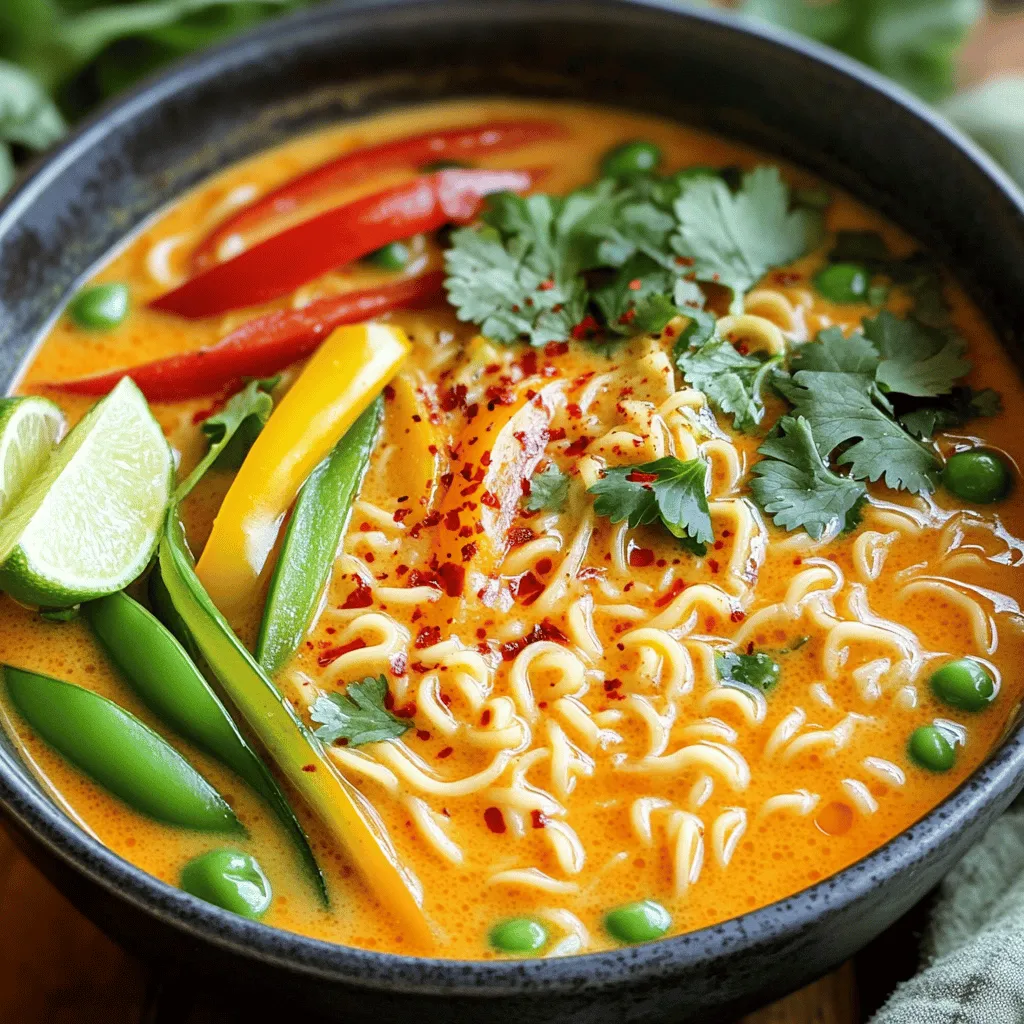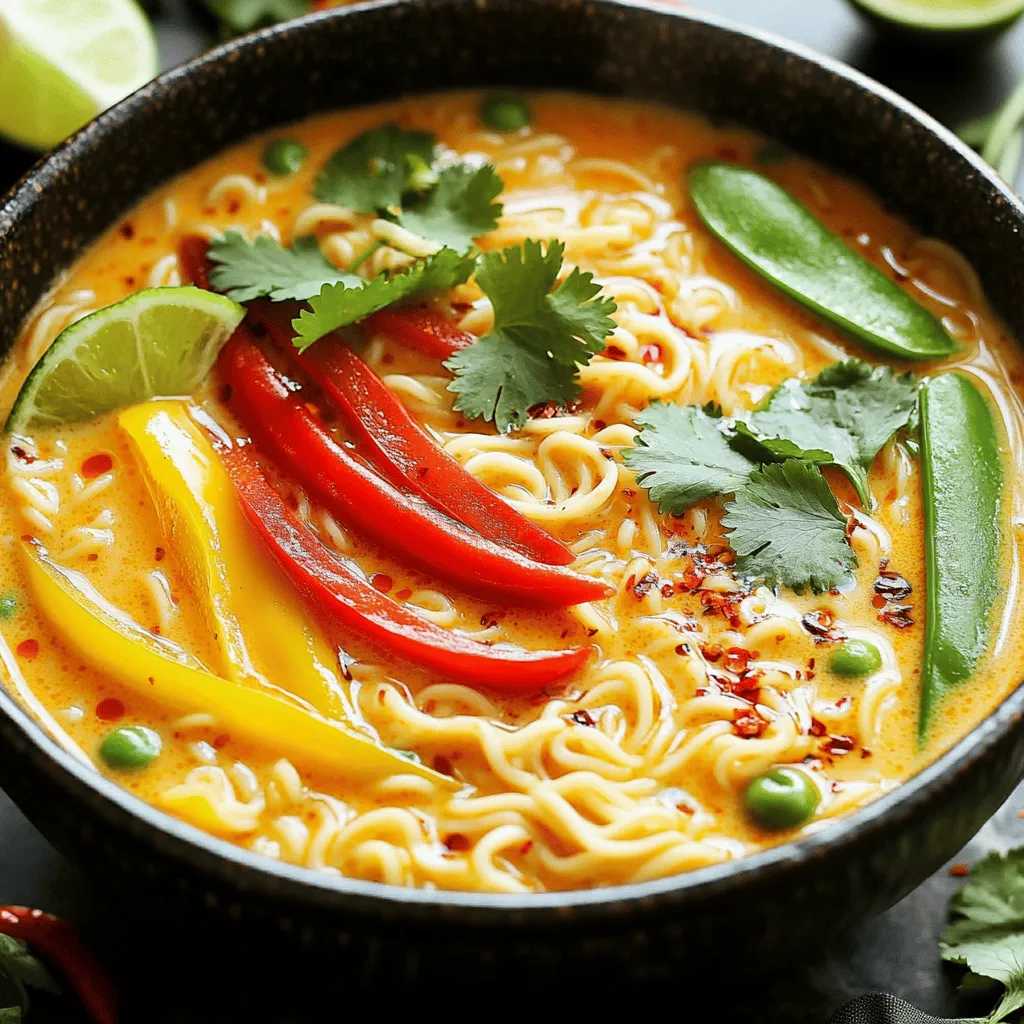Are you ready to enjoy a warm bowl of Thai Coconut Curry Ramen? This simple recipe packs bold flavors, rich coconut notes, and fresh veggies into every bite. With just a few key ingredients, you’ll have a delicious meal on the table in no time. Whether you’re a ramen lover or just want something new, this recipe will keep you satisfied. Let’s dive into these easy steps and create something special!
Ingredients
Main Ingredients
– 200g ramen noodles
– 1 can (400ml) rich coconut milk
– 2 tablespoons fragrant red curry paste
Vegetables and Seasoning
– 1 cup mixed bell peppers, sliced
– 1 cup crisp snap peas
– 1 cup sliced fresh mushrooms
– 2 cloves fresh garlic, minced
– 1 thumb-sized piece of ginger, finely grated
– 1 tablespoon soy sauce
– 1 tablespoon brown sugar
Garnishing Essentials
– Fresh cilantro leaves
– Lime wedges
– Chili flakes (optional)
Gathering the right ingredients sets you up for success. You start with ramen noodles. They are the base of this dish and provide a comforting texture. Next, you need coconut milk. This adds creaminess and a rich flavor. The red curry paste brings warmth and spice, making the broth flavorful.
For your veggies, choose a mix of colorful bell peppers. They add crunch and sweetness. Snap peas bring a fresh, crisp bite, while mushrooms give umami depth. Garlic and ginger are must-haves. They boost flavor and aroma in your curry.
Soy sauce adds saltiness, and brown sugar balances the taste. The sweetness cuts through the heat, making the dish more enjoyable.
Finally, garnishes make your ramen pop. Fresh cilantro adds a bright note. Lime wedges give a zesty kick, and chili flakes can be added for those who love spice.
With these ingredients, you create a delicious bowl of Thai coconut curry ramen.
Step-by-Step Instructions
Preparing the Ramen Noodles
– Boil about 4 cups of water in a large pot.
– Add 200g of ramen noodles and cook them for 4–5 minutes.
– Drain the noodles in a colander and set them aside.
Making the Curry Base
– Heat a tablespoon of oil over medium heat in the same pot.
– Add 2 cloves of minced garlic and a thumb-sized piece of grated ginger.
– Sauté for 1–2 minutes until fragrant.
– Add 2 tablespoons of red curry paste and stir constantly for about a minute.
Building the Curry Broth
– Pour in one can (400ml) of coconut milk and 2 cups of vegetable broth.
– Mix well to blend all the ingredients.
– Bring the mixture to a gentle simmer.
Adding Vegetables
– Add 1 cup of sliced bell peppers, 1 cup of snap peas, and 1 cup of sliced mushrooms.
– Let the curry simmer for 5–7 minutes until the veggies are tender but still crisp.
Seasoning the Dish
– Stir in 1 tablespoon of soy sauce and 1 tablespoon of brown sugar.
– Taste the curry and adjust the seasoning if needed.
– Add chili flakes for heat if you like spice.
Combining Ramen and Curry
– Carefully add the cooked ramen noodles to the pot.
– Toss them gently in the curry broth.
– Heat everything together for one more minute.
Tips & Tricks
Selecting the Right Ramen
For the best Thai coconut curry ramen, use fresh or dried ramen noodles. Fresh noodles have great texture. Dried noodles are easy to find and cook quickly. If you need a gluten-free option, try rice noodles or soba noodles made from buckwheat. Both work well and have unique flavors.
Enhancing Flavor
To add depth to your dish, consider spices like coriander or cumin. Fresh herbs like basil or mint can also boost flavor. Balance the sweetness from the brown sugar with heat from chili flakes. This mix keeps the dish exciting. Taste as you cook to find the right balance for you.
Presentation Recommendations
Serve your ramen in deep bowls for a cozy feel. Stack the noodles neatly in the center. Add colorful veggies on top for a bright look. Garnish with fresh cilantro leaves, and place lime wedges on the side. A sprinkle of chili flakes adds a nice touch of color and flavor.

Variations
Protein Additions
You can easily add protein to your Thai coconut curry ramen. Here are some options:
– Chicken: Use cooked, shredded chicken for a heartier dish.
– Shrimp: Add shrimp during the last few minutes of cooking. They cook quickly!
– Tofu: For a vegetarian option, try firm tofu. Cut it into cubes and sauté before adding.
If you want a vegan version, tofu is a great choice. It soaks up the flavors well and adds texture.
Dietary Adjustments
You might want to adjust this recipe to fit your diet. Here’s how:
– Gluten-Free: Use gluten-free ramen noodles. You can also check the soy sauce. Make sure it’s gluten-free.
– Lower Spice Levels: To make it milder, use less red curry paste. You can also skip the chili flakes.
These small changes keep the dish tasty while meeting your needs.
Alternative Vegetables
Choosing the right vegetables can boost your ramen. Here are some tips:
– Best Veggies: Seasonal vegetables like zucchini, carrots, or bok choy work well. They add color and nutrition.
– Using Leftovers: If you have leftover veggies like broccoli or spinach, toss them in. They add flavor and reduce waste.
Feel free to get creative with your vegetable choices! This dish is flexible and fun to customize.
Storage Information
Storing Leftovers
To keep your Thai coconut curry ramen fresh, store it correctly. Place leftovers in an airtight container. This helps prevent the dish from absorbing odors. Refrigerate immediately after serving. The dish lasts in the fridge for up to three days. Always check for freshness before eating.
Freezing Guidelines
If you want to save some for later, freezing works well. First, let the curry cool completely. Then, transfer it to a freezer-safe container. Make sure to leave some space for expansion. This dish can last up to three months in the freezer. To enjoy it later, thaw it in the fridge overnight. Reheat in a pot over low heat, adding a splash of broth if needed.
Meal Prep Considerations
Preparing ingredients ahead saves time. Chop your vegetables and store them in the fridge. You can also cook the ramen noodles in advance. Just keep them separate to avoid sogginess. When ready to eat, assemble your ramen bowls quickly. This makes a warm meal easy on busy days.
FAQs
What can I use instead of coconut milk?
You can try several dairy-free alternatives. Almond milk, soy milk, or oat milk work well. Use unsweetened versions to keep the flavor balanced. You can also mix in some nut butter for creaminess.
Adjusting flavors is key. If you use a milk alternative, add a bit of lime juice or tamari. This will help mimic the tangy notes of coconut milk.
Can I make this recipe in advance?
Yes, you can make this dish ahead of time. The curry flavors deepen when it sits. However, the noodles may become soft when stored.
To prepare in advance, cook the curry and store it separately from the noodles. This way, you keep the noodles firm. When ready to eat, combine them just before serving.
How do I spice up my Thai coconut curry ramen?
To add extra heat, consider fresh chili peppers or sriracha sauce. You can slice fresh jalapeños or add a few drops of hot sauce.
Using flavored oils or spicy toppings can elevate the dish. Drizzle some chili oil on top before serving for a kick. Crushed red pepper or even a sprinkle of cayenne can also enhance the flavor.
This blog covered how to make a tasty Thai coconut curry ramen. You learned about key ingredients, including noodles, coconut milk, and fresh vegetables. I shared step-by-step instructions to guide your cooking. You now have tips to enhance flavor and ideas for variations.
I believe cooking can be fun and rewarding. Try different toppings and ingredients. Taste and adjust as you go. Enjoy your delicious ramen dish and make it your own!

